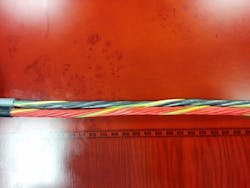This article was updated March 31, 2023. It was originally published Jan. 8, 2016.
Engineers and designers who don’t regularly work with CAT data of cables, and even some that do, can get confused over the different categories and what they mean. A few tips can simplify what appears at first to be complex.
Cable Basics
Data cables have to decouple the wire pairs they carry to prevent cross-talk. For Cat 5 cables, decoupling is taken care of by how the cables are constructed with different twisting lengths for each pair. That means for four pairs, there are four twisting lengths.
For CAT 6 cables, a plastic “distancing” cross inside the cable keeps the pairs a given distance apart to decouple them. Another approach for CAT 6 cables is to shield each pair by wrapping them in aluminum foil. The thickness determines the effectiveness of the shield. The shielding also keeps electrical signals in the cable, thus avoiding interference and degradation in nearby equipment.
For CAT 7, 7e and 7A, braided copper shielding over the pairs is needed to meet the standardized electrical values; aluminum foil is not enough.
Aluminum foil is inexpensive, but it does not do well in applications with flexible, track, or torsion cables. If a metal foil is repeatedly moved or flexed, it will crack, which decreases the shielding’s effectiveness. So some manufacturers design cables so they can move frequently without being damaged or be used in electromagnetically vulnerable areas. These firms install both an aluminum foil shield and a copper braid. This extra shielding is used on all data cables when the application calls for it, even those that are “only” Cat 5.
For cables that will bend during operation and the bending radii is small, some companies add metalized tape for more durable shielding. The tape extends the cable’s life and will not crack.
Cable Markings
Cable manufacturers often field questions about the markings on data cables, such as U/UTP and SF/UTP. Letters before the slash refer to the overall cable shield; letters after the slash refer to the pairs’ shielding. Here are some common markings:
U/UTP means Unshielded/Unshielded Twisted Pair (CAT 5 or 6 with distance cross)
F/UTP means Foil/Unshielded Twisted Pair (CAT 5 or 6 with distance cross)
SF/UTP means Shielded Foil/Unshielded Twisted Pair (CAT 5 or 6 with distance cross)
F/FTP means Foil/Foiled Twisted Pair (CAT 5 or 6 with distance cross)
U/FTP means Unshielded/Foiled Twisted Pair (Cat 6)
F/FTP means Foil shielded/Foil shielded Twisted Pair (Cat 6 and 6A)
S/FTP means Shielded/Foiled Twisted Pair (Cat 7, 7e, 7A, and 8)
SF/FTP means Shielded Foil/Foiled Twisted Pair (Cat 7, 7e, 7A, and 8)
Conductor Options
In most applications, bare copper is the preferred conducting material. However, in some applications such as the railway industry, tinned copper conductors are used due to their higher level of corrosion resistance.
Solid conductors are typically used in fixed installations, while other applications require a more flexible conductor which typically consists of several strands. Flexible conductors often have shorter lay lengths for a more flexible cable and smaller bending radius. (Lay length is distance needed to complete one revolution of the strand around the conductor. If a conductor has more than one layer, the term usually refers to the outer layer’s lay length.) For the smallest bend radii and maximum cycle quantity/service life, 19-strand conductors are used.
Jacket Options
There are a host of cable jacket materials; types and the application dictates which are best. For cables used in buildings, jackets are typically made of polyvinyl chloride or flame-retardant non-corrosive (FRNC) compounds. PVC is not halogen-free, but it’s flexible and inexpensive. FRNC compounds are halogen-free and flame retardant, and emit a less optically dense smoke, which makes evacuating a burning building easier and makes the firefighters’ job easier.
READ MORE: What Are the Differences in Industrial Ethernet Types?
Polyethylene (PE) jackets are mainly used for cables that will be outside and exposed to the elements or buried underground. These cable jackets resist moisture and exposure to the sun.
Cables used for automation in factories (a growing market), such as oil-resistant PVC blends, polyurethane (PUR), and thermoplastic elastomer (TPE) jacket compounds are selected for their top-notch oil resistance and ability to withstand mechanical stresses associated with cable tracks, drag chains and robotics.
Quality
Data cables should have their mechanical capabilities extensively tested by the manufacturers proving they will withstand the rigors of operating in continuous-flex (cable tracks) and torsion (robotics) applications. Faulty cables that can’t handle the task wind up degrading the signal quality. Manufacturers should use a combination of test equipment, such as cable tracks, torsion apparatuses, ovens and freezers, and, in some cases, specific application testing rigs, such as towers that mimic the strain and load on cables found in wind turbines.
Horst Messerer was sales manager for data, network and bus technology at Helukabel when this originally appeared.
About the Author
Horst Messerer
Sales Manager for Data, Network & BUS Technology
Horst Messerer is Sales Manager for Data, Network & BUS Technology at HELUKABEL.



